I started continuing my work on a project that may result in new filters to rid our water of estrogenic compounds. I will try to report every day about work that I have done in the lab. With this I am hoping to get people a better understanding of what being a laboratory scientist looks like.
The science of today, is the technology of tomorrow.
-Edward Teller
I got monday off because my supervisor is going to be the new chair of my university´s chemistry department so he was in meetings all day. After all, I am only a student researcher and I am handling equipment that worth ten thousand dollar. Thus I need to have supervision. Sometimes, lab work is a pain in the butt. Today was very annoying, because I had to wait a lot on equipment calibrating itself. However, I worked on something that has not been done before, and might have gotten some data that will be featured in a publication soon. Let´s get started with the third part of my Lab Chronicles.
Preparations
Well, back to the glassware. Luckily, I only had to wash 2 microscope slides, using virtually household soap and superwater. I then placed the slides into an oven that holds a constant temperature in order to dry them off. I had to clean the slides because I would later put them on the Germanium crystal of the ATR IR spectrometer I was using (if you are interested, check out my post about ATR here), and scratching it could mess up the entire ATR accessory. Again, I am handling some very expensive equipment - so I was putting a lot of effort into cleaning those slides.
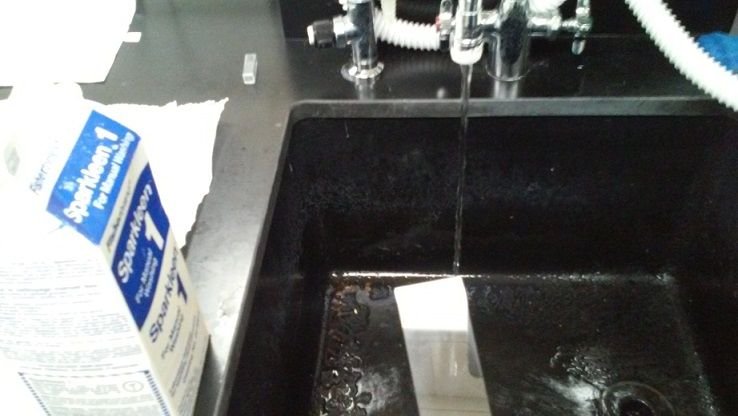
Then I also had to cool down the IR spectrometer detector. That was done by filling the machine with liquid nitrogen. It is a lot of fun to handle because it is boiling like crazy. Also you feel pretty cool when you are walking down the hall with a metal cylinder that is spitting out fumes. Liquid nitrogen is really cold, and freezes almost anything in the matter of just seconds. This outlet was in contact with liquid nitrogen for a few minutes.
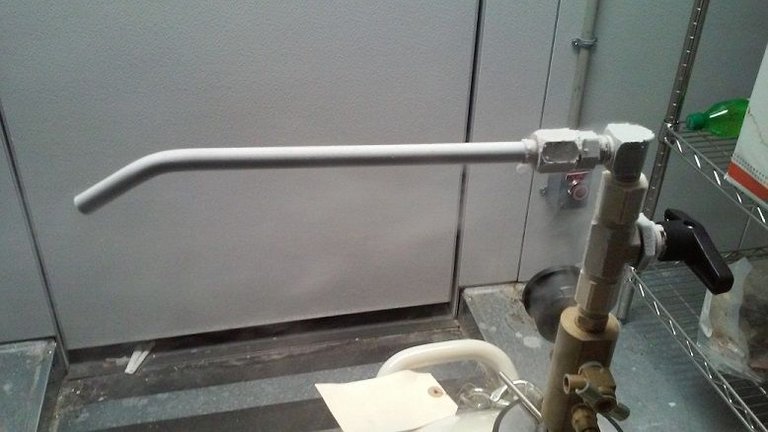
After I filled the machine with liquid nitrogen, I had to let it cool down for 30 minutes. After 30 minutes I was able to take my background measurement, only to find out that something was off. Backgrounds were taken by leaving the germanium crystal unoccupied. That just means there was no sample present. I ran two different measurements, one in single beam mode, and one in absorbance mode. The instrument gave me following graph, which I annotated for you.
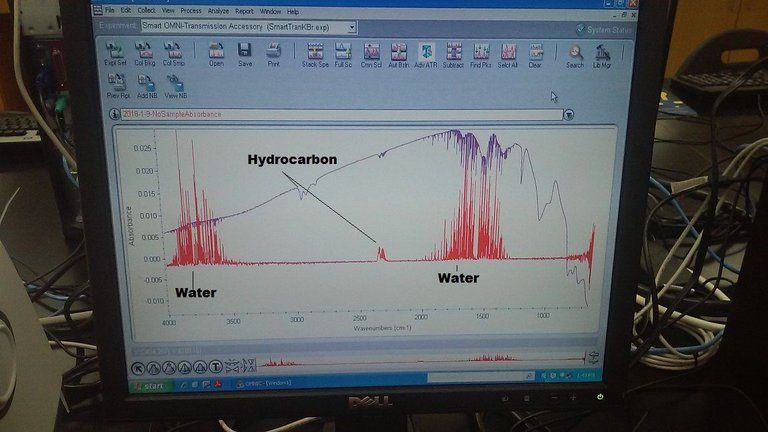
As you can see there are significant signals corresponding to rotations of the water molecule. That is not good at all because it means two things:
- It may cover or weaken signals from our actual sample
- There seems to be a leak in our gas filter
The gas filter is supposed to take air and dry it. It does so by filtering out water vapor and other contaminants. The filter says that it requires service, so that one is on my supervisor. However, we decided to play around a little bit with our equipment and settings, and tried to get some reasonable data.
Improvising Is Key
After discovering the water vapor, I went on and purged out our instrument for 30 minutes. So I had to sit around for 30 minutes. I then took another background measurement to see if we got any decrease in the intensity of the peaks that correspond to the water vapor. It did not improve at all. Then we decided to purge out the instrument for 2 hours. I was allowed to take a break.
After lunch I returned to take another background and see if there was any improvement. It had actually gotten worse. Hoping to get a decent signal, I went and took a sample measurement. The sample I used is an organic compound called 1-dodecyne. We used this because my supervisor collaborates with the patent holder of the ATR technique we have been using, and they did a study on how to simulate the ATR spectrum of a substance (and it happened to be this substance).
Luckily I can set the spectrometer to use the background I took and normalize the sample measurement against it. In theory, if the water peaks stayed constant, I could have gotten good data, even in the presence of water vapor (provided the sample peaks are larger than the water vapor peaks). And I actually got decent data, which reflects the data my supervisor found using a different technique. However, the water peaks were clearly interfering with the sample peaks and so we had to think of a better way.
I cleaned the germanium crystal using Q-tips and ethanol. However, since the crystal is so sensitive, I had to be very careful, using multiple Q-tips. It took me quite some time because it is tidious work (I had to clean the inside and outside with separate Q-tips to avoid spreading dirt from the outside. See below picture how much dirt there is).
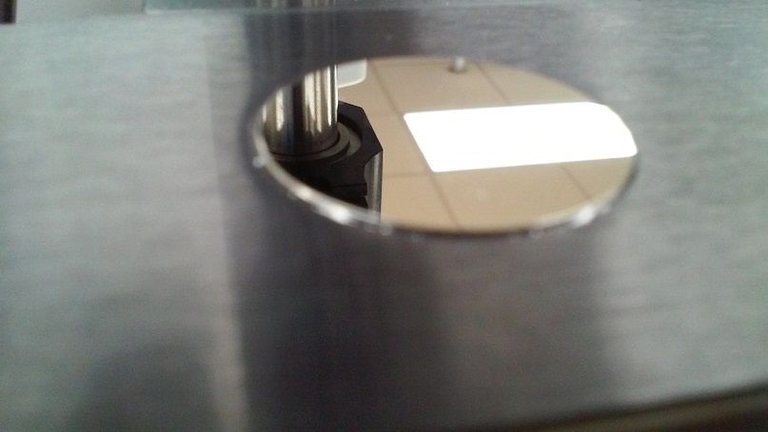
After cleaning the crystal, I had to sit around for 20 minutes to let the crystal dry. After that, I took another background measurement and then a sample measurement. But yet again, the spectrum was not good enough. So I cleaned the crystal again, and waited 20 minutes again. Same drill, background measurement and then sample measurement, and we did not get a good spectrum again. We decided to use a polarizer. This polarizer consists of a lense on which a layer of tiny aluminum wires was fixed. The wires are parallel to each other. It worths around 4000 dollars.
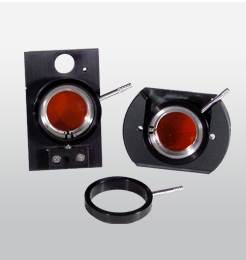
So, cleaning the crystal again, and then waiting 20 minutes again - I know, it is getting quite repetitive.
After fitting the polarizer, and setting it to 0 degree from the plane, I ran a background. It looked just as bad as the previous ones. I switched the polarizer to 90 degrees from plane and took another background, which also looked bad. I then ran a sample measurement at 90 degree from plane and for the first time today I felt some success. The spectrum almost perfectly fitted the spectrum I had for comparison. Returning the polarizer into 0 degrees from plane I ran another sample measurement, and this time, the spectrum looked even better than the spectrum I had for comparison.
So persistence pays off. At this point, I would like to acknowledge that one measurement takes around 10 minutes, because the instrument I used adjusted to the atmosphere every time I change the settings, or started a measurement run. That was a huge pain and is a glitch that we need to fix soon.
Overall, it was a very long day (I worked seven hours in the lab). I am not getting paid for this at all. The only reason why I am doing this is because I really enjoy it. I know, it seems boring, repetitive and time-consuming, but I am generating data that no one has done before, while developing methods that nobody has used before. I am at the forefront of human knowledge and it is a lot of fun to gain knowledge that may benefit people in the future.
Thank you very much for reading my post! I really enjoy my work in the laboratory, however, I do understand that this is not for everyone.
I refrained from showing data in the later parts of this post because we may publish it.
If you liked this post, please upvote it and check our my channel. I am trying to give you a look behind the curtains.
Cheers @lesshorrible!
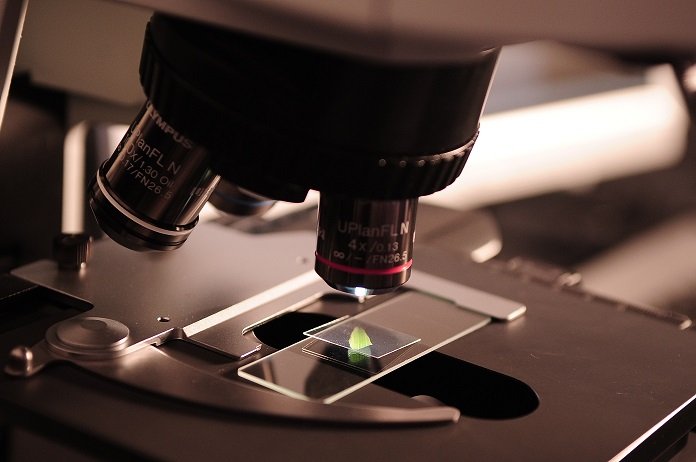
Dang man this project took a lot of time and effort. Thanks for letting us get a free college education !
wow, you definitely must like science and you have to be very patient to do everything so meticulously, I hope to continue reading you
Thank you very much @jennifer.jimenez! I am going to write another post later tonight about what I have done today. It was all worth it in the end, but more later. Cheers!
Then publish it first, and then write a new post about it ^^
I once in a while write about my own research, especially when a paper is just out.
Will do! Just give me a couple of weeks. I actually just managed to get some good results today using the accessory that I have been working with the last two days. Just got done with lab today, so I will write about it later tonight. Thank you for the comment and your support! Cheers!
^^
@originalworks
The @OriginalWorks bot has determined this post by @lesshorrible to be original material and upvoted it!
To call @OriginalWorks, simply reply to any post with @originalworks or !originalworks in your message!